 [Somehow, that last sentence didn’t quite fit the flow of things]. Next came the editorial [Workplace Depression: Personalize, Partner, or Pay the Price] with the opening lines I quoted above [I can pretty much guarantee you that Diego Rivera would rise from the grave if he could and denounce this editorial, throwing red paint on as many copies as he could get his hands on]. The editorial ends with:
[Somehow, that last sentence didn’t quite fit the flow of things]. Next came the editorial [Workplace Depression: Personalize, Partner, or Pay the Price] with the opening lines I quoted above [I can pretty much guarantee you that Diego Rivera would rise from the grave if he could and denounce this editorial, throwing red paint on as many copies as he could get his hands on]. The editorial ends with: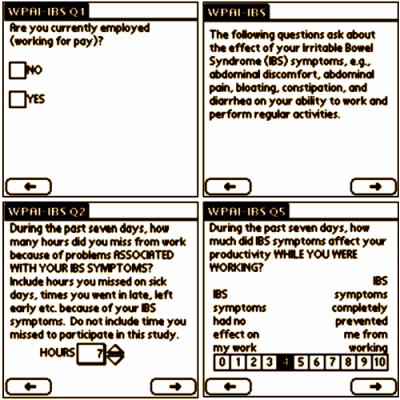
[WPAI: example from Irritable Bowel Syndrome]
Increase in Work Productivity of Depressed Individuals With Improvement in Depressive Symptom Severity
by Madhukar H. Trivedi, M.D.; David W. Morris, Ph.D.; Stephen R. Wisniewski, Ph.D.; Ira Lesser, M.D.; Andrew A. Nierenberg, M.D.; Ella Daly, M.B., M.R.C.Psych.; Benji T. Kurian, M.D., M.P.H.; Bradley N. Gaynes, M.D.; G.K. Balasubramani, Ph.D.; and A. John Rush, M.D.
American Journal of Psychiatry 2013 170:633–641.
Objective: The authors sought to identify baseline clinical and sociodemographic characteristics associated with work pro- ductivity in depressed outpatients and to assess the effect of treatment on work productivity.Method: Employed depressed outpatients 18 – 75 years old who completed the Work Productivity and Activity Impairment scale [N=1,928] were treated with citalopram [20 – 40 mg/day] in the Sequenced Treatment Alternatives to Relieve Depression study. For patients who did not remit after an initial adequate antidepressant trial [level 1], either a switch to sertraline, sustained-release bupropion, or extended-release venlafaxine or an augmentation with sustained-release bupropion or buspirone was provided [level 2]. Participants’ clinical and demographic characteristics and treatment outcomes were analyzed for associations with baseline work productivity and change in productivity over time.Results: Education, baseline depression severity, and melancholic, atypical, and recurrent depression subtypes were all in- dependently associated with lower benefit to work productivity domains. During level 1 treatment, work productivity in several domains improved with reductions in depressive symptom severity. However, these findings did not hold true for level 2 outcomes; there was no significant association between treatment response and reduction in work impairment. Results were largely confirmed when multiple imputations were employed to address missing data. During this additional analysis, an association was also observed between greater impairment in work productivity and higher levels of anxious depression.Conclusions: Patients with clinically significant reductions in symptom severity during initial treatment were more likely than nonresponders to experience significant improvements in work productivity. In contrast, patients who achieved symptom remission in second-step treatment continued to have impairment at work. Patients who have demonstrated some degree of treatment resistance are more prone to persistent impairment in occupational productivity, implying a need for additional, possibly novel, treatments.
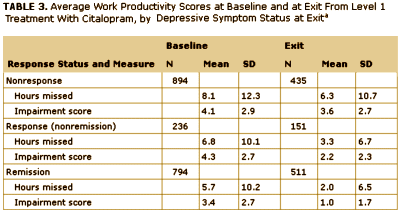
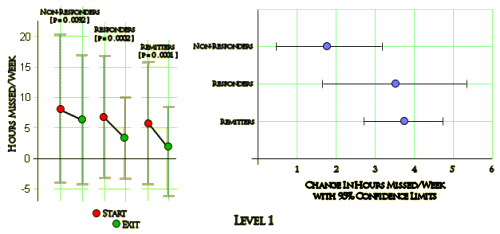
What bothered me more was what always bothers me when STAR*D is in the picture – the drop-out rate and missing data rate is extremely high. And in Table 3, they didn’t use the start values that they had exit values for. They used all of the start values [1924] compared with the exit values [1097]. So the results suggest a continuity that’s not really there [1-(1097/1924)=43% missing exit values from drop-outs or failure to phone home]. It becomes even more tangled because with the Level 2 data, they only reported subjects if they had both start and exit data.
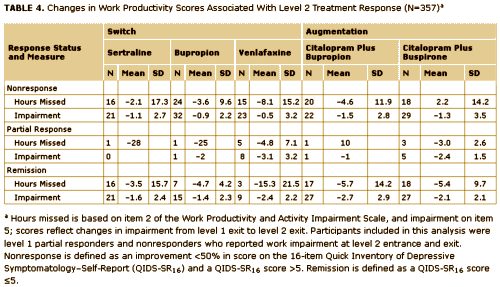
They say this Level 2 table shows non significance. I guess I’ll take their word for it [I couldn’t figure out a way to vet it]. And with STAR*D papers, we must always include this part:
| Dr. Trivedi has received research support from or served as an adviser, consultant, or speaker for Abbott Laboratories, Abdi Ibrahim, Agency for Healthcare Research and Quality, Akzo (Organon Pharmaceuticals), Alkermes, AstraZeneca, Axon Advisors, Bristol-Myers Squibb, Cephalon, Corcept Therapeutics, Cyberonics, Eli Lilly, Evotec, Fabre Kramer Pharmaceuticals, Forest Pharmaceuticals, Glaxo-SmithKline, Janssen Pharmaceutica Products, Johnson & Johnson PRD, Libby, Lundbeck, Mead Johnson, MedAvante, Medtronic, Merck, National Institute on Drug Abuse, NARSAD, Naurex, Neuronetics, NIMH, Novartis, Otsuka Pharmaceuticals, Pamlab, Parke-Davis Phar- maceuticals, Pfizer, PgxHealth, Pharmacia & Upjohn, Predix Pharmaceuticals (Epix), Rexahn Pharmaceuticals, Roche Products, Sepracor, Shire Development, Sierra, SK Life and Science, Solvay Pharmaceuticals, Takeda, Transcept, VantagePoint, and Wyeth- Ayerst Laboratories. |
| Dr. Wisniewski has served as a consultant for Dey Pharmaceuticals and Venebio and has received grant support from Eli Lilly. Dr. Lesser has received grant support from NIMH.. |
| Dr. Nierenberg has received research support from or served as an adviser, consultant, or speaker for AstraZeneca, Basilea Pharmaceutica, Brain Cells, Bristol-Myers Squibb, Cederroth, Cyberonics, Dainippon Sumitomo, Eli Lilly, EpiQ, Forest Pharmaceuticals, Genaissance, GlaxoSmithKline, Janssen Pharmaceutica, Jazz Pharmaceuticals, Innapharma, Lichtwer Pharma, Eli Lilly, Merck, Neuronetics, Novartis, Organon, Pamlab, Pfizer, PGx Health, NIMH, NARSAD, Sepracor, Shire, Stanley Foundation, Targacept, Takeda, Wyeth-Ayerst Labora- tories, and Massachusetts General Psychiatry Academy (MGHPA talks are supported through Independent Medical Education grants from AstraZeneca, Eli Lilly, and Janssen Pharmaceuticals); he has equity holdings (excluding mutual funds/blind trusts) in Appliance Comput- ing. . |
| Dr. Daly is currently a full-time employee and stockholder of Johnson & Johnson PRD; at the time of this study, she was an assistant professor at the University of Texas Medical Center, Dallas, where she continues to hold a position as adjunct faculty. . |
| Dr. Kurian has received research grant support from Evotec, Forest Pharmaceuticals, Johnson & Johnson, Naurex, NIMH, Pfizer, Rexahn, and Targacept. . |
| Dr. Gaynes has received research support from or served as an adviser, consultant, or speaker for the Agency for Healthcare Research and Quality, Bristol-Myers Squibb, GlaxoSmithKline, M-3 Corporation, NIMH, Novartis, Ovation Pharmaceuticals, Pfizer, Robert Wood Johnson Foundation, Shire Pharmaceuticals, and Wyeth-Ayerst.. |
| Dr. Rush has received research support from Duke-National University of Singapore Graduate Medical School and NIMH; consulting fees from Brain Resource, Otsuka, and University of Michigan; speaking fees from Singapore College of Family Physicians; royalties from Guilford Publications and the University of Texas Southwestern Medical Center; and travel support from Collegium Internationale Neuro-Psychopharmacologicum. . |
| The other authors report no financial relationships with commercial interests.. |
| Supported by NIMH contract N01MH90003 to University of Texas Southwestern Medical Center at Dallas [principal investigator, Dr. Rush]. Medications for this trial were provided at no cost by Bristol- Myers Squibb, Forest Laboratories, GlaxoSmithKline, King Pharma- ceuticals, Organon, Pfizer, and Wyeth.. |
| Clinicaltrials.gov identifier: NCT00021528.. |
| The authors acknowledge the editorial support of Jon Kilner, M.S., M.A.. |
In case you don’t recall, Jon Kilner is a medical writer whom I presume to be the ghost-writer/editor for the whole STAR*D enterprise when he’s not writing science fiction. Look here for what I could find a couple of years back:
I’ve already concluded the the STAR*D Trial was a $35 M misunderstanding for countless reasons and wouldn’t have bothered with this iteration had it not been displayed so prominently. But going through it, it has the same kind of internal flaws and non-transparency as so many of its predecessors. Even if taken at face value, the changes in missed hours and subjective self-reported impairment are small. I suspect that the always-missing primary outcome variable [HDRS] and the huge drop-out and missing data rates in STAR*D resulted from the impersonal and mechanized way the study was conducted [check lists done over the phone]. Had I been a subject, I would have felt like a depersonified part of an algorithmic treatment machine. And the list of the authors’ industry connections [in spite of being a NIMH Study] just adds to its industrial feel.
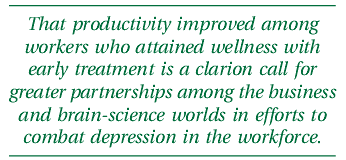
The accompanying editorial feels the same way – a pitch to Managed Care and industry in general to support the pharmaceutical industry [and its academic allies] in developing drugs to increase productivity in the workplace, following the future-think motif so prevalent in the psychiatry of the last three decades [Workplace Depression: Personalize, Partner, or Pay the Price].

Those who have taken upon themselves to define what’s true, right, scientifically valid, have no trouble with a mural and its creator, to fit it and him within their parameters, to fit their outlook, their view of humanity and the world.
Yes, the edifice of scientific, medical psychiatry sucks, as many of its primarily male master builders and underwriters.
Artists too must eat, drink too, and womanizing can be costly. Diego Rivero may have needed the money..
For optimism and a fresher outlook, I’ll reread Models of Madness, the new edition out in May, hot on the heels of the discredited DSM-5, edited by John Read and the expert activist Jacki Dillon
a depression treatment pitch to employers at the same time employers are held responsible for high health costs and poor quality in NYT
http://economix.blogs.nytimes.com/2013/06/07/the-culprit-behind-high-u-s-health-care-prices/
June 7, 2013, 12:01 am 14 Comments
The Culprit Behind High U.S. Health Care Prices
By UWE E. REINHARDT
“Alas, in their self-appointed role as purchasing agents in health care, American employers have arguably become the sloppiest purchasers of health care anywhere in the world.
The chaotic price system for health care is one manifestation of that sloppiness.
For more than half a century, employers have passively paid just about every health care bill that has been put before them, with few questions asked.
And all along they have been party to a deal to keep the chaotic price system they helped create opaque from the public and even from their own employees. “
JACQUI DILLON. Names shall be correct. I was checking it, when I hit send instead.
Instead of reading American Journal of Psychiatry, I’v sent for “Mental Health and Human Rights: Vision, Praxis and Courage” by Dudley, Silove, Gale, Oxford University Press 2012. That’s to be my summer study – and a choice selection of America’s best blogs… Thank you!
Nice presentation of the journal. Are you really surprised about the content when given the source?
Just beware, desperation makes for poor choices, and the APA is showing that mentality. Oh, by the way, they want $69 for the little pocketbook edition of DSM 5?
In their dreams!
Mickey,
This daily, high-quality investigative reporting is Pulitzer Prize material. Thank you for doing this.
Richard
I agree, a Pulitzer Prize. Or maybe McArthur grant.
Jobs themselves are a huge source of distress. We’ve come full circle in, I guess, neo-liberalism, to recommending drugging workers to make their work more bearable….urrrr….I mean, increase productivity. Because that’s what life is all about, right?
Why not just widely dispense speed….urrr, I mean ADD drugs? That’ll do wonders for productivity.
George Orwell and Aldous Huxley saw clearly where the world was headed.
i think this is part of a long term campaign to promote “national depression centers” which http://www.nndc.org/
National Crisis
Depression and bipolar illness impact one in five Americans. They cost our economy billions of dollars a year in lost productivity. More is spent treating them than treating cancer, yet up to half of sufferers do not receive the care they need. There are too few trained practitioners, too little research funding, and too much lingering stigma.
it is another step in a grand plan led by greden
“clarion call for greater partnerships among the business and brain-science worlds”
“What steps need to be taken by mental health investigators and business leaders to begin rolling out this potential? ”
“accelerate efforts to develop personalized precision treatments for depression ”
“depression has multiple underlying and interactive brain pathophysiologies, …Comparable to other major medical disorders, the right treatment needs to be found for the underlying pathophysiologies at the right time.”
“Greater partnerships among business leaders, clinical translational investigators, and clinical delivery networks will be required to roll out such intervention programs on a large scale, but the payoff should be profound”
” the search for biomarkers and personalized treatment strategies should be accelerated in large, standardized, longitudinal samples.”
“Truly large samples, tens of thousands rather than tens or hundreds, will be required.”
“Early prototypes such as the National Network of Depression Centers (10) have been started for depression, bipolar illness, and related conditions, but financial supports will be needed to fully develop their potential.”
“The findings by Trivedi et al. in this issue (3) addressed only productivity gains, but in doing so, the authors provide a tantalizing peek at a promising vision.
Full-scale workplace initiatives, network partnerships, personalized treatment development, and prevention programs will promote profitability rather than raising costs.
This vision is attainable.”
The NNDC unites the top institutions in the diagnosis, treatment and prevention of depression and bipolar illness to advance knowledge, improve care and drive the national conversation.
Our Network
DONATE to NNDC TodayWelcome! The National Network of Depression Centers (NNDC) is a non-profit 501(c)(3) network of 20 leading clinical and academic Centers of Excellence in the U.S working to transform the field of depressive illnesses and related mood disorders.
sorry for sloppy cut and pastes in above comment
should read
i think this is part of a long term campaign to promote “national depression centers”
this seems like step in grand plan of national network of depression centers
http://www.nndc.org/
National Crisis
Depression and bipolar illness impact one in five Americans. They cost our economy billions of dollars a year in lost productivity. More is spent treating them than treating cancer, yet up to half of sufferers do not receive the care they need. There are too few trained practitioners, too little research funding, and too much lingering stigma.
The NNDC unites the top institutions in the diagnosis, treatment and prevention of depression and bipolar illness to advance knowledge, improve care and drive the national conversation.
Our Network
DONATE to NNDC TodayWelcome! The National Network of Depression Centers (NNDC) is a non-profit 501(c)(3) network of 20 leading clinical and academic Centers of Excellence in the U.S working to transform the field of depressive illnesses and related mood disorders.
——————————————————
the pitch made in the article
“clarion call for greater partnerships among the business and brain-science worlds”
“What steps need to be taken by mental health investigators and business leaders to begin rolling out this potential? ”
“accelerate efforts to develop personalized precision treatments for depression ”
“depression has multiple underlying and interactive brain pathophysiologies, …Comparable to other major medical disorders, the right treatment needs to be found for the underlying pathophysiologies at the right time.”
“Greater partnerships among business leaders, clinical translational investigators, and clinical delivery networks will be required to roll out such intervention programs on a large scale, but the payoff should be profound”
” the search for biomarkers and personalized treatment strategies should be accelerated in large, standardized, longitudinal samples.”
“Truly large samples, tens of thousands rather than tens or hundreds, will be required.”
“Early prototypes such as the National Network of Depression Centers (10) have been started for depression, bipolar illness, and related conditions, but financial supports will be needed to fully develop their potential.”
“The findings by Trivedi et al. in this issue (3) addressed only productivity gains, but in doing so, the authors provide a tantalizing peek at a promising vision.
Full-scale workplace initiatives, network partnerships, personalized treatment development, and prevention programs will promote profitability rather than raising costs.
This vision is attainable.”
the board of directors of the national network of depression centers
http://www.nndc.org/about-us/organization/board-of-directors/
Board of Directors
Executive Committee
Founding Chair
John F. Greden, MD
University of Michigan Comprehensive Depression Center
Vice Chair
J. Raymond DePaulo, Jr, MD
The Johns Hopkins Mood Disorders Center
Treasurer
Frank V. deGruy III, MD, MSFM
University of Colorado Denver Depression Center
Secretary
Terence A. Ketter, MD
Stanford University
Member-at-Large
Paul E. Keck, Jr., MD
University of Cincinnati & Lindner Center of HOPE
Member-at-Large
James Potash, MD, MPH
University of Iowa Mood Disorders Center
Board Members
Jonathan E. Alpert, MD, PhD – Massachusetts General Hospital, Partners HealthCare – Harvard Medical School
Martha Bruce, PhD, MPH – Weill Cornell Medical College
William Coryell, MD – University of Iowa Mood Disorders Center
W. Edward Craighead, PhD – Emory University
Boadie Dunlop, MD – Emory University
Stuart J. Eisendrath, MD – University of California San Francisco Comprehensive Depression Center
Graham J. Emslie, MD – University of Texas Southwestern Medical Center
Dwight L. Evans, MD – University of Pennsylvania
Mark Frye, MD – Mayo Clinic
Constance Guille, MD – Medical University of South Carolina Comprehensive Depression Center
Mustafa Husain, MD – Duke University
Kay Redfield Jamison, PhD – Johns Hopkins University Mood Disorders Center
David Katzelnick, MD – Mayo Clinic
James H. Kocsis, MD – Weill Cornell Medical College
Anand Kumar, MD – University of Illinois at Chicago
Sarah H. Lisanby, MD – Duke University
Melvin McInnis, MD – University of Michigan Comprehensive Depression Center
Ghanshyam N. Pandey, PhD – University of Illinois at Chicago
Scott L. Rauch, MD – McLean Hospital, Partners HealthCare – Harvard Medical School
Anthony J. Rothschild, MD – UMass Medical School / UMass Memorial Health Care
Alan F. Schatzberg, MD – Stanford University
David Silbersweig, MD – Brigham & Women’s Hospital, Partners HealthCare – Harvard Medical School
Stephen M. Strakowski, MD – University of Cincinnati & Lindner Center of Hope
Allan Tasman, MD, DFAPA, FRCPsych – University of Louisville Depression Center
Michael E. Thase, MD – University of Pennsylvania
Marshall Thomas, MD – University of Colorado Denver Depression Center
Madhukar H. Trivedi, MD – University of Texas Southwestern Medical Center
Thomas Uhde, MD – Medical University of South Carolina Comprehensive Depression Center
Sandra Weiss, PhD, DNSc, FAAN – University of California San Francisco Comprehensive Depression Center
Jesse H. Wright, MD, PhD – University of Louisville Depression Center
Douglas M. Ziedonis, MD, MPH – UMass Medical School / UMass Memorial Health Care
Yes, Alostrata. When I heard that there was a drug on the market named “SOMA” I had to laugh. The KOLs and BigPharma combined sometimes appear to have read 1984 and thought, ‘That’s a great idea!’
American workers are famously productive. We could be more productive workers with regular working hours and paid vacations, but NO, the answer is for psychiatry to serve the business community in an effort to squeeze every last drop of blood out of the turnips with mood and mind altering drugs.
I keep telling Dr. Mickey that I am in awe of his output and of its quality. Today’s post confirms that impression. The suggestion for a MacArthur Foundation award is very appropriate.
Dean Brooks, ‘Cuckoo’s Nest’ Doctor, Dies at 96
http://www.nytimes.com/2013/06/01/arts/dean-brooks-cuckoos-nest-doctor-dies-at-96.html?_r=0
Just saw a comment on another website about corporate math:
1.Pick a conclusion 2.ask for data that supports that conclusion 3.refine data request to exclude contradicting data 4. mess with the graph data points and scale until the results you want appear. 5. Triumphantly announce the conclusion is supported by rock solid data and do what you wanted to do in the first place Step six is “wonder why it’s not suddenly raining puppies and unicorns like the data said it would”, but that rarely makes it into the meetings.
In an effort to check all the risks of all the medications I’m taking, I’ve been busy over at RxISK.org. The lists of drug interactions are long. So it has me wondering— do doctors and other prescribing professionals have a cross-referenced data-base that allows them to, for instance, bring up a list of all drugs and other substances that are contraindicated to the one(s) a particular patient is taking, or bring up all the drugs that are contraindicated because of a patient’s medical condition or conditions? Or all the possible side-effects of a drug individually or combined with another drug which could help determine if a patient’s new symptom might be caused by the drug(s) rather than the disease? If not, it would certainly be beneficial to have one, and to use it to gather data about the effects of multiple drugs.
Since no psychiatrist or counselor ever asked me if I was on the pill (which put me in a miserable state that disappeared when I stopped taking it) and many women suffer what could be labeled as “depression” on the pill, I’m thinking that should also be in the database, along with menopause and other women’s health issues. And doctors and psychiatrists should ask women about these medical conditions and drugs when considering the source of mood states. If anyone has done research on “depression” and hormone treatments for women, I’d love to see how much of the “depression” that women appear to suffer from so much more than men, can be attributed to the pill and other medical uses of hormones.
Alcohol, nicotine, and caffeine should also be included along with over the counter drugs, and supplements that can be helpful or harmful in combination with other drugs.
With iatrogenic death and injury being a booming business right now, it makes more sense for doctors and psychiatrists to work on algorithms and data bases for preventing harm than escalating cocktails.
jamzo,
Thank you for the link regarding the passing of Dr. Dean Brooks.
Mad in America posted a great video on his work and had plans to do regular updates. He seemed like a good man. –
http://www.madinamerica.com/2013/01/mia-reports-meet-dr-dean-brooks/
And I’m in the choir with all who think Dr. Nardo deserves an award for this website.
Best,
Duane
Jamzo,
You seem spot on with this ‘national depression centers’ point [http://www.nndc.org/]. Gulp!
The fact that the American Journal of Psychiatry publishes this STAR*D nonsense shows that the profession has become intellectually (and perhaps ethically) bankrupt.
University of Texas officials have confirmed to me that Madhukar Trivedi is under investigation for potential research misconduct. The new fluff piece in AJP will deepen his problem.
http://www.nlm.nih.gov/medlineplus/magazine/issues/summer07/articles/summer07pg13.html
The author of the editorial seems oblivious to his confluence of the terms “oppression” “The Great Depression” and “depression (disorder)”. I’m quite sure this hint of social psychiatry is unintended.
persistent, treatment resistant oppression with comorbid poverty
The idea that employers would identify “low-productive” workers as in need of psychiatric treatment gives me the creeps. I guess those are the rats that aren’t swimming as energetically as the others.
NNDC board of directors = the usual suspects
Alto,
Great analogy!
Rats in need of psychosocial rehabilitation…comrade?
“CBPR projects start with the community. Community is often self-defined, but general categories of community include geographic community, community of individuals with a common problem or issue, or a community of individuals with a common interest or goal. CBPR encourages collaboration of “formally trained research” partners from any area of expertise, provided that the researcher provide expertise that is seen as useful to the investigation by the community, and be fully committed to a partnership of equals and producing outcomes usable to the community. Equitable partnerships require sharing power, resources, credit, results, and knowledge, as well as a reciprocal appreciation of each partner’s knowledge and skills at each stage of the project, including problem definition/issue selection, research design, conducting research, interpreting the results, and determining how the results should be used for action.”
https://en.wikipedia.org/wiki/Community-based_participatory_research